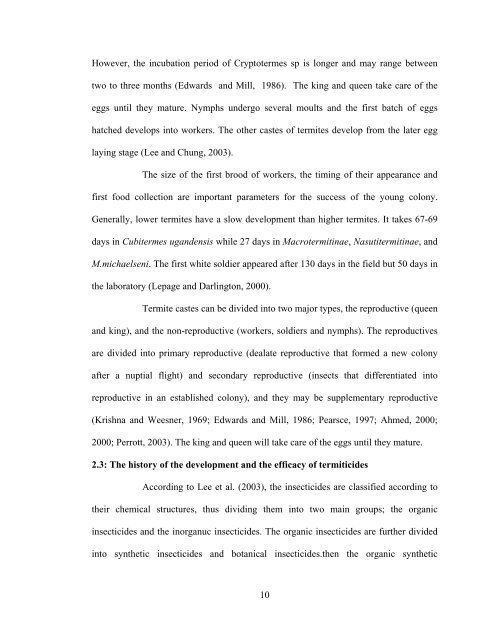SALAH SALEM OBAID GURBEL - ePrints@USM
SALAH SALEM OBAID GURBEL - ePrints@USM
SALAH SALEM OBAID GURBEL - ePrints@USM
You also want an ePaper? Increase the reach of your titles
YUMPU automatically turns print PDFs into web optimized ePapers that Google loves.
However, the incubation period of Cryptotermes sp is longer and may range between<br />
two to three months (Edwards and Mill, 1986). The king and queen take care of the<br />
eggs until they mature. Nymphs undergo several moults and the first batch of eggs<br />
hatched develops into workers. The other castes of termites develop from the later egg<br />
laying stage (Lee and Chung, 2003).<br />
The size of the first brood of workers, the timing of their appearance and<br />
first food collection are important parameters for the success of the young colony.<br />
Generally, lower termites have a slow development than higher termites. It takes 67-69<br />
days in Cubitermes ugandensis while 27 days in Macrotermitinae, Nasutitermitinae, and<br />
M.michaelseni. The first white soldier appeared after 130 days in the field but 50 days in<br />
the laboratory (Lepage and Darlington, 2000).<br />
Termite castes can be divided into two major types, the reproductive (queen<br />
and king), and the non-reproductive (workers, soldiers and nymphs). The reproductives<br />
are divided into primary reproductive (dealate reproductive that formed a new colony<br />
after a nuptial flight) and secondary reproductive (insects that differentiated into<br />
reproductive in an established colony), and they may be supplementary reproductive<br />
(Krishna and Weesner, 1969; Edwards and Mill, 1986; Pearsce, 1997; Ahmed, 2000;<br />
2000; Perrott, 2003). The king and queen will take care of the eggs until they mature.<br />
2.3: The history of the development and the efficacy of termiticides<br />
According to Lee et al. (2003), the insecticides are classified according to<br />
their chemical structures, thus dividing them into two main groups; the organic<br />
insecticides and the inorganuc insecticides. The organic insecticides are further divided<br />
into synthetic insecticides and botanical insecticides.then the organic synthetic<br />
10







![[Consumer Behaviour] - ePrints@USM](https://img.yumpu.com/21924816/1/184x260/consumer-behaviour-eprintsusm.jpg?quality=85)








